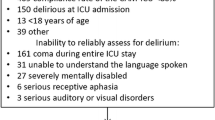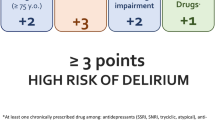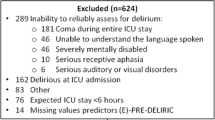Abstract
Background A delirium is common in hospital settings resulting in increased mortality and costs. Prevention of a delirium is clearly preferred over treatment. A delirium risk prediction model can be helpful to identify patients at risk of a delirium, allowing the start of preventive treatment. Current risk prediction models rely on manual calculation of the individual patient risk. Objective The aim of this study was to develop an automated ward independent delirium riskprediction model. To show that such a model can be constructed exclusively from electronically available risk factors and thereby implemented into a clinical decision support system (CDSS) to optimally support the physician to initiate preventive treatment. Setting A Dutch teaching hospital. Methods A retrospective cohort study in which patients, 60 years or older, were selected when admitted to the hospital, with no delirium diagnosis when presenting, or during the first day of admission. We used logistic regression analysis to develop a delirium predictive model out of the electronically available predictive variables. Main outcome measure A delirium risk prediction model. Results A delirium risk prediction model was developed using predictive variables that were significant in the univariable regression analyses. The area under the receiver operating characteristics curve of the “medication model” model was 0.76 after internal validation. Conclusions CDSSs can be used to automatically predict the risk of a delirium in individual hospitalised patients’ by exclusively using electronically available predictive variables. To increase the use and improve the quality of predictive models, clinical risk factors should be documented ready for automated use.

Similar content being viewed by others
References
Inouye SK, Westendorp RG, Saczynski JS. Delirium in elderly people. Lancet. 2014;383(9920):911–22.
Siddiqi N, House AO, Holmes JD. Occurrence and outcome of delirium in medical in-patients: a systematic literature review. Age Ageing. 2006;35(4):350–64.
Leslie DL, Marcantonio ER, Zhang Y, Leo-Summers L, Inouye SK. One-year health care costs associated with delirium in the elderly population. Arch Intern Med. 2008;168(1):27–32.
Salluh JI, Wang H, Schneider EB, Nagaraja N, Yenokyan G, Damluji A, et al. Outcome of delirium in critically ill patients: systematic review and meta-analysis. BMJ. 2015;350:h2538.
Inouye SK, Bogardus ST Jr, Charpentier PA, Leo-Summers L, Acampora D, Holford TR, et al. A multicomponent intervention to prevent delirium in hospitalized older patients. N Engl J Med. 1999;340(9):669–76.
Inouye SK, van Dyck CH, Alessi CA, Balkin S, Siegal AP, Horwitz RI. Clarifying confusion: the confusion assessment method. A new method for detection of delirium. Ann Intern Med. 1990;113(12):941–8.
Trzepacz PT, Mittal D, Torres R, Kanary K, Norton J, Jimerson N. Validation of the delirium rating scale-revised-98: comparison with the delirium rating scale and the cognitive test for delirium. J Neuropsychiatry Clin Neurosci. 2001;13(2):229–42.
Schuurmans MJ, Shortridge-Baggett LM, Duursma SA. The Delirium Observation Screening Scale: a screening instrument for delirium. Res Theory Nurs Pract. 2003;17(1):31–50.
Young J, Leentjens AF, George J, Olofsson B, Gustafson Y. Systematic approaches to the prevention and management of patients with delirium. J Psychosom Res. 2008;65(3):267–72.
Inouye SK. Delirium in older persons. N Engl J Med. 2006;354(11):1157–65.
Teslyar P, Stock VM, Wilk CM, Camsari U, Ehrenreich MJ, Himelhoch S. Prophylaxis with antipsychotic medication reduces the risk of post-operative delirium in elderly patients: a meta-analysis. Psychosomatics. 2013;54(2):124–31.
Kalisvaart KJ, de Jonghe JF, Bogaards MJ, Vreeswijk R, Egberts TC, Burger BJ, et al. Haloperidol prophylaxis for elderly hip-surgery patients at risk for delirium: a randomized placebo-controlled study. J Am Geriatr Soc. 2005;53(10):1658–66.
Young J, Murthy L, Westby M, Akunne A, O’Mahony R. Guideline development G. Diagnosis, prevention, and management of delirium: summary of nice guidance. BMJ. 2010;341:c3704.
Laurila JV, Laakkonen ML, Tilvis RS, Pitkala KH. Predisposing and precipitating factors for delirium in a frail geriatric population. J Psychosom Res. 2008;65(3):249–54.
Inouye SK. Predisposing and precipitating factors for delirium in hospitalized older patients. Dement Geriatr Cogn Disord. 1999;10(5):393–400.
van den Boogaard M, Pickkers P, Slooter AJ, Kuiper MA, Spronk PE, van der Voort PH, et al. Development and validation of PRE-DELIRIC (PREdiction of DELIRium in ICu patients) delirium prediction model for intensive care patients: observational multicentre study. BMJ. 2012;344:e420.
Inouye SK, Viscoli CM, Horwitz RI, Hurst LD, Tinetti ME. A predictive model for delirium in hospitalized elderly medical patients based on admission characteristics. Ann Intern Med. 1993;119(6):474–81.
Carrasco MP, Villarroel L, Andrade M, Calderon J, Gonzalez M. Development and validation of a delirium predictive score in older people. Age Ageing. 2014;43(3):346–51.
Douglas VC, Hessler CS, Dhaliwal G, Betjemann JP, Fukuda KA, Alameddine LR, et al. The AWOL tool: derivation and validation of a delirium prediction rule. J Hosp Med. 2013;8(9):493–9.
de Wit HA, Mestres Gonzalvo C, Hurkens KP, Mulder WJ, Janknegt R, Verhey FR, et al. Development of a computer system to support medication reviews in nursing homes. Int J Clin Pharm. 2013;35(5):668–72.
Lin Y, Chen J, Wang Z. Meta-analysis of factors which influence delirium following cardiac surgery. J Card Surg. 2012;27(4):481–92.
Smulter N, Lingehall HC, Gustafson Y, Olofsson B, Engstrom KG. Delirium after cardiac surgery: incidence and risk factors. Interact CardioVasc Thorac Surg. 2013;17(5):790–6.
World Health Organisation. http://www.whocc.no/atc/structure_and_principles/ [updated 2011-03-25; cited 2015-12-27].
Maher RL, Hanlon J, Hajjar ER. Clinical consequences of polypharmacy in elderly. Expert Opin Drug Saf. 2014;13(1):57–65.
Hajjar ER, Cafiero AC, Hanlon JT. Polypharmacy in elderly patients. Am J Geriatr Pharmacother. 2007;5(4):345–51.
Peduzzi P, Concato J, Kemper E, Holford TR, Feinstein AR. A simulation study of the number of events per variable in logistic regression analysis. J Clin Epidemiol. 1996;49(12):1373–9.
Fan J, Upadhye S, Worster A. Understanding Receiver Operating Characteristic (ROC) Curves. Cjem. 2006;8(1):19–20.
Harrell FE. Regression modeling strategies : with applications to linear models, logistic regression, and survival analysis. New York: Springer; 2001; xxii, 568 p.
Herr M, Robine JM, Pinot J, Arvieu JJ, Ankri J. Polypharmacy and frailty: prevalence, relationship, and impact on mortality in a French sample of 2350 old people. Pharmacoepidemiol Drug Saf. 2015;24(6):637–46.
Clegg A, Young J, Iliffe S, Rikkert MO, Rockwood K. Frailty in elderly people. Lancet. 2013;381(9868):752–62.
Hein C, Forgues A, Piau A, Sommet A, Vellas B, Nourhashémi F. Impact of polypharmacy on occurrence of delirium in elderly emergency patients. J Am Med Dir Assoc. 2014;15(11):850.e11–5.
Stusser RJ, Dickey RA. Quality and cost improvement of healthcare via complementary measurement and diagnosis of patient general health outcome using electronic health record data: research rationale and design. J Med Syst. 2013;37(6):9977.
Minne L, Ludikhuize J, de Rooij SE, Abu-Hanna A. Characterizing predictive models of mortality for older adults and their validation for use in clinical practice. J Am Geriatr Soc. 2011;59(6):1110–5.
Soman S, Zasuwa G, Yee J. Automation, decision support, and expert systems in nephrology. Adv Chronic Kidney Dis. 2008;15(1):42–55.
Maviglia SM, Zielstorff RD, Paterno M, Teich JM, Bates DW, Kuperman GJ. Automating complex guidelines for chronic disease: lessons learned. J Am Med Inform Assoc. 2003;10(2):154–65.
Acknowledgments
We thank Eugene Hardy for aiding in the retrieval of the delirium diagnosis dates.
Funding
The SCREEN-study was supported by a grant from ZonMW, Grant Number 113101001.
Conflicts of interest
The authors declare no conflict of interest.
Author information
Authors and Affiliations
Corresponding author
Appendix
Rights and permissions
About this article
Cite this article
de Wit, H.A.J.M., Winkens, B., Mestres Gonzalvo, C. et al. The development of an automated ward independent delirium risk prediction model. Int J Clin Pharm 38, 915–923 (2016). https://doi.org/10.1007/s11096-016-0312-7
Received:
Accepted:
Published:
Issue Date:
DOI: https://doi.org/10.1007/s11096-016-0312-7




